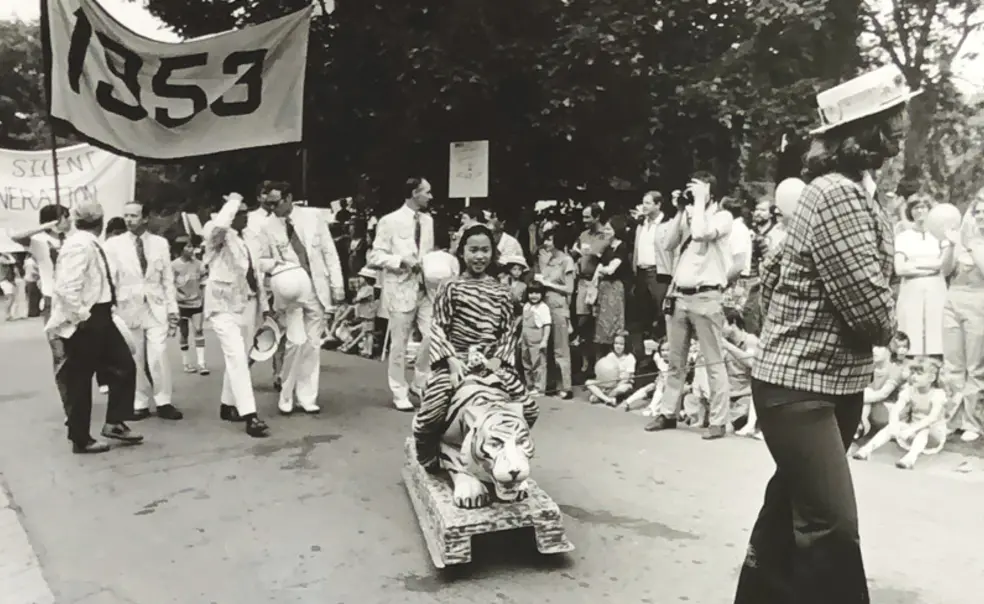Early Reunions Organizers Fought to Bar Women From the P-rade — and Lost
They do not ‘fundamentally belong,’ wrote an alum in 1958
We don’t know his name, but an alum who identified himself as “Old Guardsman” was sufficiently annoyed in 1914 to write a letter to PAW. Women were marching in the P-rade, and Old Guardsman didn’t like it. “[I]t would seem to me to swell the numbers by the wives, sweethearts, and sisters, is a mistake, aside from the bad taste involved,” he wrote.
Princeton reunions today are known for their family-friendly nature. Spouses and children are welcome, and no one considers their presence to be in bad taste. But as that letter illustrates, not everyone has always been happy about it.
Both Reunions in general and the P-rade in particular seem to have been family affairs from the beginning. As far back as 1906, as the Class of 1886 prepared for its 20th, its class secretary placed a notice in PAW declaring, “Princeton expects every ’86 man to do his duty next June. Come early! Stay late! Bring the Wives, Boys, and Girls with you!”
Still, when Old Guardsman wrote to PAW less than a decade later, he may have been in a grumpy minority, but he seems to have hit a nerve. In 1915, the committee organizing the P-rade published a set of rules that contained the following, italicized: “Only graduates and former students of the University, and their sons” would be permitted to march.
From the evidence we have, many alumni ignored the rule. As Reunions historian Tom Tulenko ’67 has discovered, photos from that era show wives in attendance, as well as children, male and female, decked out in class gear. In 1922, the fifth reunion Class of 1917 asked “those proud papas who intend bringing their children” to notify class officers so costumes could be ordered for them.
For some, the disagreement about female participation was a philosophical one — Reunions were supposed to be a time for class members to renew old friendships and revisit their bygone youth — although a dose of good old-fashioned misogyny can’t be ruled out, either. Others had a more nuanced objection: It was fine for female family members to participate, but dates and girlfriends, who had no connection to Princeton, were too much.
The trend towards female participation accelerated after World War II, as Americans placed greater emphasis on family togetherness. Still, many holdouts remained. In 1949, several classes voted to ban women except for certain events. “This has been done,” the Class of 1943 said in its Class Notes, “because of limited facilities and also because many men feel the original purpose of [R]eunions is being destroyed by the ever-growing number of women who invade the tents on Friday and Saturday nights.”
Within a few years, isolated grumbling became a full-on revolt, which reached a head at a 1951 meeting of the Graduate Council, a predecessor of the Alumni Council. While acknowledging that class wives and daughters “have always been, and I trust always will be” welcome, Reunions chair George Cooke ’36 thought that limits should be set. “I think that you will all admit that the presence of women in tents, except in the more formal family functions, is a distracting influence at best, especially when the women are not limited to the wives and daughters of the class,” Cooke said.
With support from President Harold Dodds *1914, a group called the Reunions Chairmen’s Association unanimously adopted a resolution that stated that “all Princeton Classes should exclude women from their Reunions Headquarters ... and should bar all women over 16 years of age, including wives and daughters, from the Alumni P-rade.” As PAW noted, however, “Responsibility for compliance with the resolution rests with each individual class.” Compliance appears to have been spotty, and there is no record of the prohibition being enforced. The resolution was republished in 1952 and 1953, then quietly dropped.
As even Reunions chauvinists might have conceded, they were swimming against the tide. In 1955, PAW reported that 150 wives and nearly 350 children from the Class of 1935 had come back for the 20th. Families, though, were housed off-campus rather than in the still-not-coed dorms, and special programming was designed to keep them entertained. During Friday night’s class-only dinner, the ’35 wives were taken to the movies in Lambertville to see The Merry Widow starring Lana Turner and Fernando Lamas.
Even so, there were some like William Attwood ’41, who griped to PAW in February 1958 that family attendance “has turned what used to be an interlude of convivial beer-drinking and amiable nostalgia into a nerve-wracking jamboree combining the worst of parents’ day at the nursery school and a get-acquainted barbecue at the new country club.”
“It’s bad enough trying to remember the names of several dozen balding, heavy-set virtual strangers without having to recall all the Nancys, Bettys, and Carolines they’ve got in tow,” he added.
Attwood’s letter sparked a predictable — and from the modern vantage point, grimly entertaining — war of replies in PAW. Alumni curmudgeons came out in force. “He has put the finger unerringly on one of the most devastating of the post-war trends,” wrote Henry Kirkland 1924, “the increasingly ubiquitous presence of the female of the species at functions . . . where she does not fundamentally belong.” David Helm 1896 boasted that he had missed only three Reunions in 61 years but “[n]ever could see why a Princeton man coming to the June reunion to meet old classmates and recall younger days should have at the same time to be a meal ticket for a family picnic.”
On the other hand, wrote Jack Platten ’38, while some events such as the class dinner might remain stag, “Reunion weekend is, and in my memory always has been, essentially for the families.” John P. Bennett ’47 proposed splitting the difference: Let wives come but leave the “hollering hordes of children” at home.
They were fighting a losing battle. Looking back in 1964, Joseph Bradshaw ’40 wrote, “Each year more and more men return with their wife and their children as well. This family influence, we would like to feel, has set a higher tone to Reunions without lessening its aspect of pure fun.” But even then, PAW noted, the graduating seniors, “for the first time in many years,” voted to prohibit dates from joining them in the P-rade.
Over the decades, an informal distinction emerged: Kids, girls as well as boys, could march with their fathers, but women watched from the sidelines. As Anne Rivers Siddons s’48 wrote in her 1973 PAW essay, “Reunions Make Me Cry,” “We wives clung closer together, in tight knots, feeling our men draw away from us at last and into the body of ’48, into a whole where we couldn’t follow, as if into the ranks of Eleusinian initiates.” Younger wives weren’t so impressed, and over time, began to step off the sidewalks and march beside their husbands.
With the advent of coeducation in 1969, when women were finally welcomed into the Princeton ranks, those bars were dropped once and for all. “Reunions are joining many of the other Princeton institutions this year that are ending an era with the graduating Class of 1969,” Robert Durkee ’69, then PAW’s On the Campus columnist, noted.
“The all-male Reunion is biting the dust.”












No responses yet